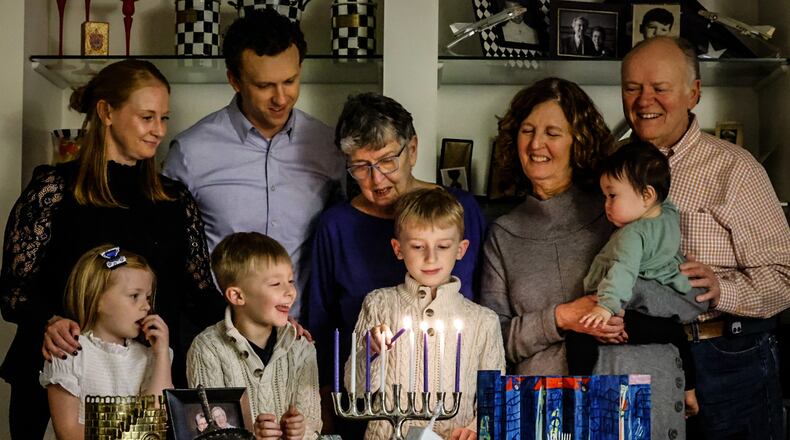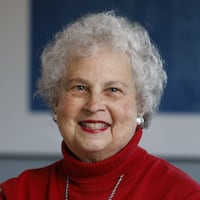When it’s time to light the first candle, many gather with friends and family.
Here’s a look at some of the most beloved Hanukkah traditions and the ways in which some of the folks in our area will be celebrating the holiday.
Lighting the menorah
The best-known symbol of Hanukkah is the menorah, the Hebrew word for lamp. Also called a “hanukkiah,” menorahs have nine branches and come in a wide variety of artistic styles. There are electric menorahs and while they may be safer, they’re not as much fun!
The branch that stands above rest is known as the shamash and is used to light the others. Accompanied by melodious Hebrew blessings, an additional candle is added each night until by the end of the holiday, all of the candles are burning. Some folks invite others to bring their own menorah, then all join together to sing the blessings and light the candles. It’s traditional to put the menorah in a window once it’s lit.
Credit: JIM NOELKER
Credit: JIM NOELKER
“Growing up, Hanukkah was really about family time,” says Daniel Sweeny of Centerville. " We would all gather at my grandparents’ house to light the menorah and exchange gifts. The house was always packed with family and friends.” These days, when his extended family gathers, there are 37 people.
Daniel says his grandparents, Joe and Elaine Bettman, always instilled in their children and grandchildren their love of Jewish values and traditions. “Those memories stand out because Hanukkah embodies the spirit of Judaism: perseverance, togetherness and the belief in something bigger than oneself. "
Daniel’s wife, Janese, says Hanukkah is also a time to reflect on the past year and all of their blessings. “We are extremely fortunate to have a wonderful family and extended family in town, as well as a support network of amazing friends in our Jewish community,” she says. " Hanukkah provides time for us to pause and be thankful. Lighting the menorah each night is a sign of hope and a sign of all that was, is, and is to come.”
Holiday activities
Games, songs, special foods and gift-giving are all part of a Hanukkah celebration. So is giving back to the less fortunate.
“As the year winds down we anticipate the time we get to spend with all of our friends and family members every night of Hanukkah,” says Julie Atkin of Centerville. “We enjoying spending this time with our Jewish family and friends as well as sharing our traditions and customs with our non Jewish family and friends.”
Atkin says it isn’t simply about the gifts. “We try to celebrate every night in a very special way,” she explains “For example, we pick a different book for each night, wrap the books in brown paper and number them one through eight. Every night we open one book and read the book together as a family or with friends and family that are there to celebrate. Our family favorite Hanukkah book is “Hanukkah Bear” by Eric Kimmel. "
Credit: Contributed
Credit: Contributed
Most of the books, she explains, are sent to the family thanks to PJ library, a program offering free books to Jewish children as they grow. “Then we have an activity planned to go along with those books.” Those activities range from creating clay menorahs and dancing to playing memory- matching games. Chocolate coins are ingredients for the family’s S’mores and Star of David treats are made from chocolate pretzels.
Playing the game of “dreidel” is a must. The spinning top has Hebrew letters on each of its sides. Where it lands determines how many tokens are earned. The tokens can be anything from coins to candy.
Some families do a “mitzvah” or good deed on one of the days of Hanukkah. Those may range from giving toys to homeless shelters to distributing food at a local pantry.
Jewish Family Service in Dayton invites crafty community members to do a “Knitzvah,” to make hand-knitted, crocheted or sewn hats, scarves, socks or gloves that are distributed to homebound folks in the community.
Hanukkah foods
Eating fried foods is a Hanukkah custom that harkens back to the miracle associated with the Temple in Jerusalem. It’s said that although there was only enough oil to burn for one day, the oil miraculously lasted for eight days. Popular foods include “sufganiyot,” a deep-fried or jelly-filled doughnut and potato pancakes or “latkes,” fried to a golden brown.
Cathy Gardner, CEO of the Jewish Federation of Greater Dayton, has fond memories of frying lots of latkes for family and friends when she hosted an annual Hanukkah party in her Florida hometown. " I would use 10 lbs. of potatoes to make enough latkes to satisfy the demand,” she recalls. " I spent the entire time in the kitchen frying the latkes as they were consumed immediately. A line would form at the counter for ‘hot out of the pan latkes. The house would smell but it was worth it!”
Gardner shares these tried-and-true tips for those who’d like to try their hand at latke-making:
- I use a recipe of Yukon potatoes, scallions, sweet onions and eggs. For every 2 lbs. of potatoes, 1 cup of scallions, 1 large onion (or 2 small) and 1 egg. Fry in either canola or vegetable oil.
- You can use a hand grater for the potatoes and onions. A food processor also works. Once potatoes are peeled, make sure to put in cold water so they do not turn color. Take one potato at a time and grate, placing the grated potato back in the water. Let potatoes rest in water while grating onion and chopping scallions. You want to have the potato starch settle to the bottom of the bowl. This is used later when mixing all the ingredients.
- Once all potatoes have been grated, use a salad spinner to extract as much liquid as possible and transfer to a new mixing bowl. You can further extract water (less water = crispier latkes) by using a kitchen towel.
- Pour off liquid in the original bowl used for potatoes. The starch should be a white sediment at the bottom. Use that to mix with all the other ingredients. Mix, season with salt and pepper and fry.
- I grab a small handful of potato mixture, form a loose ball and place in the frying pan. I like using an electric frying pan since it is easiest to regulate temperature. Once the mixture begins to fry, flatten with spatula and fry on both sides to desired crispiness.
- Some people use grated veggies like zucchini or carrots instead of potatoes.
- Top the latkes with sour cream, applesauce or both.. " I consider it blasphemous, but some people use both on the same latke! A tip I learned from Martha Stewart is to add caviar to the sour cream. Yum!
Giving gifts
GIfts are traditionally given during Hanukkah, but they needn’t be big or expensive. Some families give a larger gift on the first night, then trinkets on the others.
The presents don’t need to relate to the holiday, but that’s always nice. A great source for a wide range of Judaica are synagogue gift shops.
" We have a wide selection of items for every Jewish holiday – from Hanukkah to Passover,” says Tammy Evans, office manager at Beth Jacob Synagogue. The shop also stocks jewelry, books, Sabbath candlesticks, Bar and Bat Mitzvah gifts, children’s holiday games and toys.
The Beth Jacob Gift Shop is located at 7020 North Main Street in Harrison Township. Hours are 10 a.m. to 3 p.m. Monday through Friday by appointment. Call Evans at 937-274-2149.
Credit: Contributed
Credit: Contributed
The Beth Abraham Synagogue Gift Shop is managed by the congregation’s Sisterhood. Chair Connie Roberts says in addition to a wide selection of Hanukkah-related gifts, you’ll also find other Jewish objects including mezuzahs (traditionally affixed to the doorpost of a Jewish home), wine cups and Havdalah sets (used for the ceremony that marks the end of the Sabbath). The synagogue is located at 305 Sugar Camp Circle, in Oakwood. For an appointment, call Roberts at 937-293-9520.
Credit: Contributed
Credit: Contributed
About the Author








